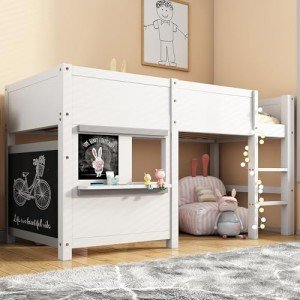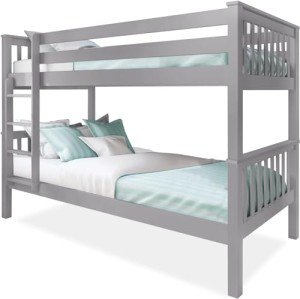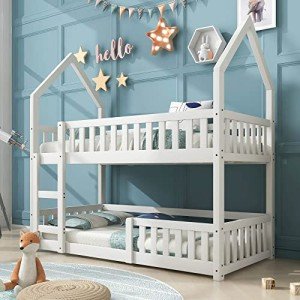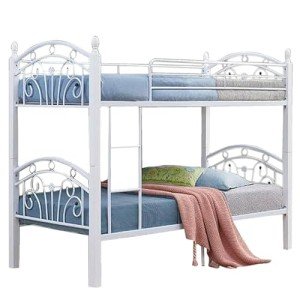As living spaces continue to shrink in urban environments, the search for practical and innovative furniture solutions has become increasingly important for families, especially those with children. Enter the shorty kids bunk bed—a compact, sturdy, and space-saving solution that merges functionality with fun. This guide will delve into the benefits of shorty bunk beds, their design features, the materials used, safety considerations, and how they can maximize space in a child’s bedroom.
Understanding Shorty Kids Bunk Beds
Shorty kids bunk beds refer to beds designed specifically for children that are shorter than standard bunk beds. These beds typically feature two stacked sleeping surfaces, which allow siblings or friends to share a space without taking up unnecessary floor area. The lower height is particularly beneficial for younger children, making it easier to access the top bunk safely.
Key Benefits
-
Space-Saving Design: One of the most significant advantages of shorty bunk beds is their compact design that allows for more floor space to be utilized for play and activities.
-
Versatility: Many shorty bunk beds come with added features such as built-in storage drawers or shelves, providing additional organization solutions for children's belongings.
-
Sturdy and Safe: Made from high-quality materials, these beds are designed to withstand the hustle and bustle of childhood, ensuring durability as children grow.
-
Fun Factor: Bunk beds inherently carry an element of adventure for kids, making bedtime a more enjoyable experience.
Design Considerations
When selecting a shorty kids bunk bed, several design elements should be considered to ensure that it meets both aesthetic and functional needs.
-
Material: Sturdy materials such as solid wood or metal frames are ideal for durability.
-
Finishes: Non-toxic finishes are essential to ensure the health and safety of children.
-
Mattress Size: Shorty bunk beds typically use twin mattresses, but some models may accommodate shorter mattresses, so it’s essential to check compatibility.
-
Height and Weight Limit: Ensure the bunk bed can safely support the weight of the desired occupants, and verify that the height is suitable for your child's age to reduce the risk of falls.
Safety Features
Safety is paramount when choosing a shorty kids bunk bed. Here are some essential safety features to look for:
-
Guardrails: Top bunks should have solid guardrails on all open sides to prevent accidental falls during sleep.
-
Ladder Design: A sturdy ladder with wide steps should be included for easy access to the top bunk. Some models have ladders that can be mounted on either side of the bed.
-
Stability: The frame should be designed to ensure stability, and it should be anchored securely to the wall if required.
-
Weight Distribution: High-quality bunk beds are designed to effectively distribute weight evenly to prevent tipping.
-
Age Recommendation: It's advisable to follow the manufacturer’s age recommendations, usually suggesting that children under six should not sleep in the top bunk.
Maximizing Space with Shorty Bunk Beds
Utilizing a shorty kids bunk bed can open up many options for room layout and organization. Here are practical ways to maximize space:
-
Under-Bed Storage: Many shorty bunk beds come with built-in drawers or space underneath, allowing for easy storage of toys, clothes, or even a trundle bed for sleepovers.
-
Dual Purpose: Some designs feature a desk or play area beneath the top bunk providing a dedicated space for homework or craft activities.
-
Zoning: The placement of a bunk bed can define “zones” in a room—separating sleeping from play areas and creating a sense of order.
-
Vertical Arrangements: Opting for vertical arrangements rather than side-by-side beds can utilize height to maximize floor space effectively.
Frequently Asked Questions
Q1. Are shorty kids bunk beds safe for younger children?
A1. Yes, shorty bunk beds are generally safer for younger children due to their lower height and the presence of guardrails. However, it is essential to consider the manufacturer's recommendations for age and weight limits.
Q2. What size mattresses do shorty bunk beds require?
A2. Most shorty bunk beds require a standard twin mattress, but some may require shorter mattresses, so it's vital to check specifications before purchasing.
Q3. Can shorty bunk beds be converted to separate beds?
A3. Many shorty bunk beds can be separated into two single beds, providing flexibility as children's needs change over time.
Q4. How do I maintain a shorty bunk bed?
A4. Regularly inspect for loose screws, check the stability of the frame, and clean the surfaces with non-toxic cleaners. Keeping bedding clean and dry also enhances hygiene.
Q5. Where can I purchase shorty kids bunk beds?
A5. Shorty kids bunk beds can be found at furniture retailers, specialized children’s furniture stores, and online marketplaces.
The shorty kids bunk bed is a prime example of how clever design can facilitate better living conditions in smaller homes. With their sturdy construction, safety features, and space-saving capabilities, these beds provide an excellent solution for families with children. With considerations for safety and versatility, shorty bunk beds not only serve as a stylish addition to a child's bedroom but also enrich their living and play space. As families continue to migrate toward urban environments with limited space, shorty kids bunk beds stand out as a smart investment for the future.






